I’m really pleased to see that my efforts to progress and develop my skills and practices appear to be paying off and showing through within my work. I really feel I have progressed so much since beginning my journey and have tried to really take heed of the advice offered to me by my tutors, so it is nice to see this is transparent and acknowledged.
My tutor has provided me with some rather essential information and advice in this part’s feedback and I hope to continue building on this as it has thus far been invaluable in the progression of my artist voice.
Artist Recommendations
As always, I decided to carry out some research into the works of the artists recommended by my tutor, the results of which are as shown below.
Ivon Hitchens
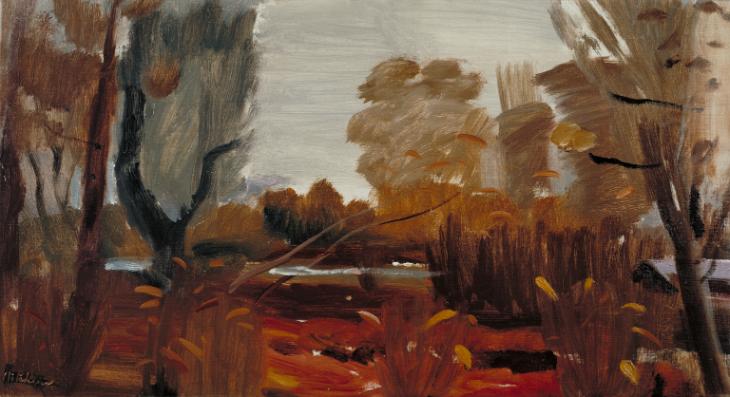
Fig. 1. Hitchens, I. Damp Autumn (1941) 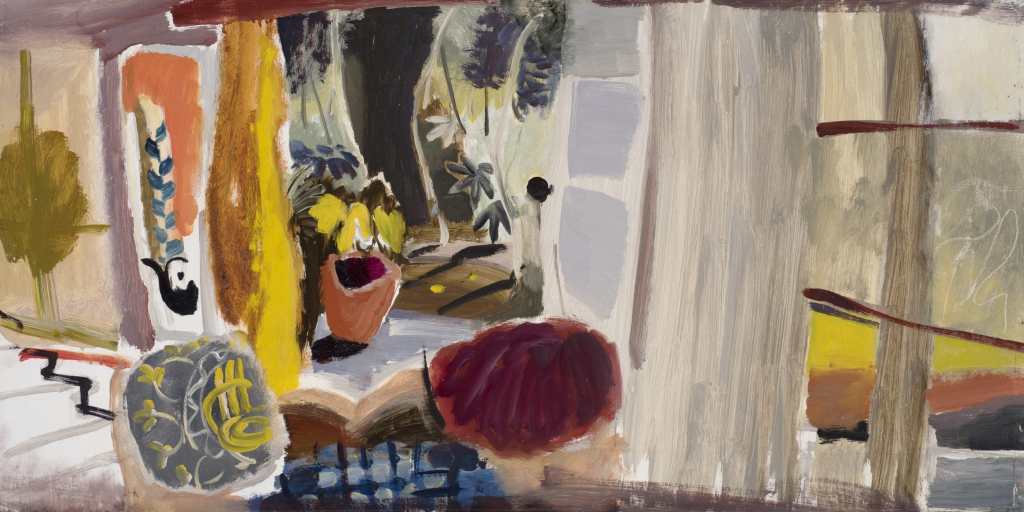
Fig. 2. Hitchens, I. Studio with Open Doors (c.1942) 
Fig. 3. Hitchens, I. River Rother, Dark Evening (1951)
I really like the style used by this artist with the almost block colours and shapes. The artist seems to use the simplest of marks with a complete confidence in what he wants to achieve. It is as though he knows precisely what he wants to create without the need for experiment and recovery of errors. I really like this confidence and I feel I can learn a lot from it. I should definitely aspire to this level of confidence within my own work.
Maki Na Kamura
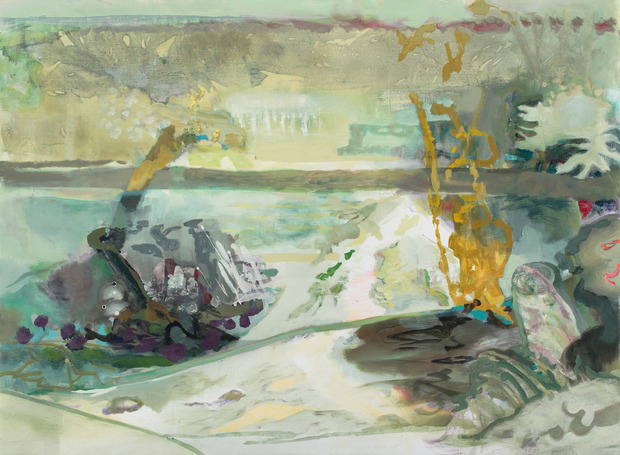
Fig. 4. Na Kamura, M. PML IX (2008) 
Fig. 5. Na Kamura, M. fGf XXVII (2011) 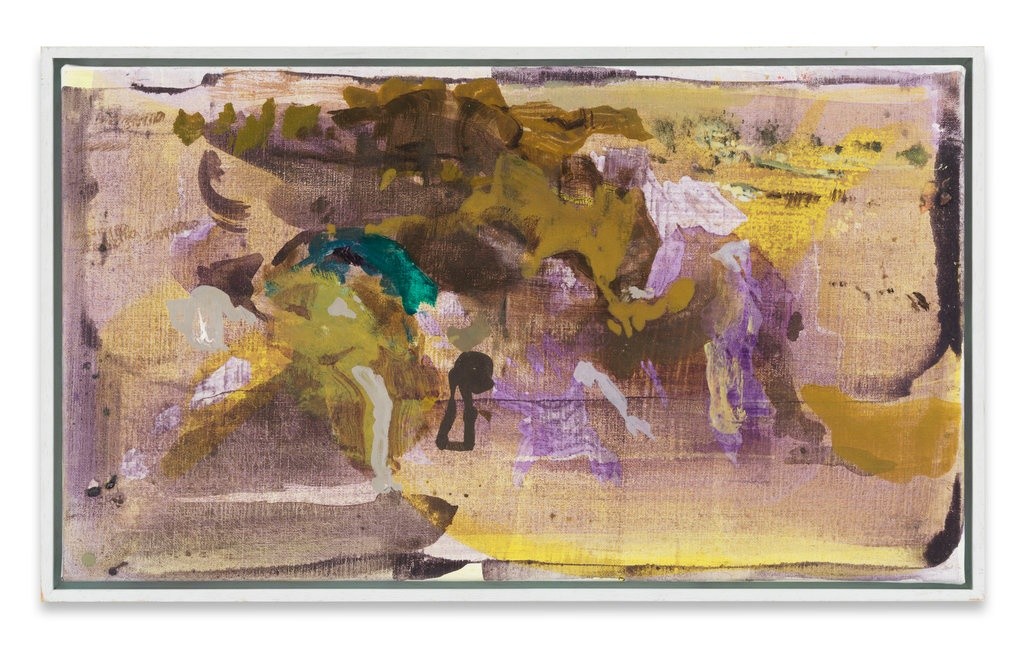
Fig. 6. Na Kamura, M. dXd XXIII (2017)
The fluidity of the marks made within the works created by this artist are utterly beautiful to behold. The colours are very delicately applied and the contrast between light and dark is rather subtle in some areas, yet deep and powerful in others. There is so much movement within the pieces and, considering what my tutor said about how the works take on their own form and truth of being, I think this artist has truly mastered that concept.
Annabel Emson
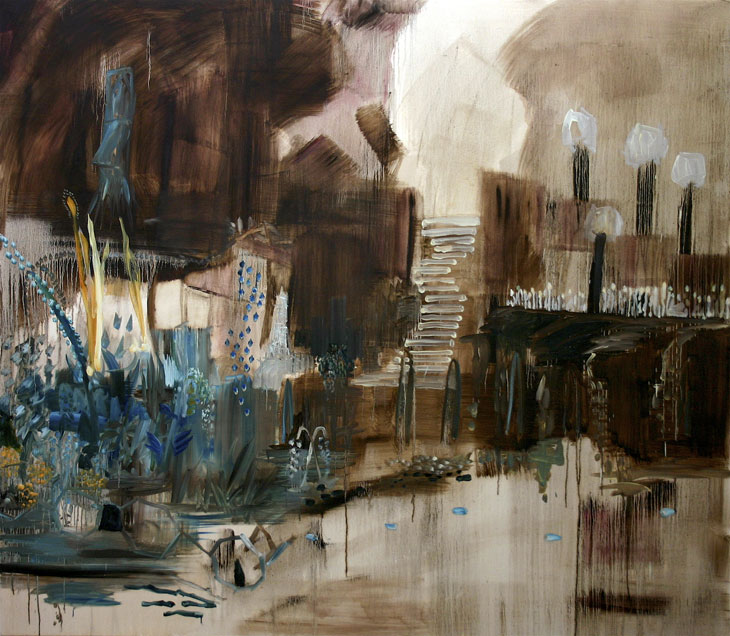
Fig. 7. Emson, A. Steps (2006) 
Fig. 8. Emson, A. Heaven (2006) 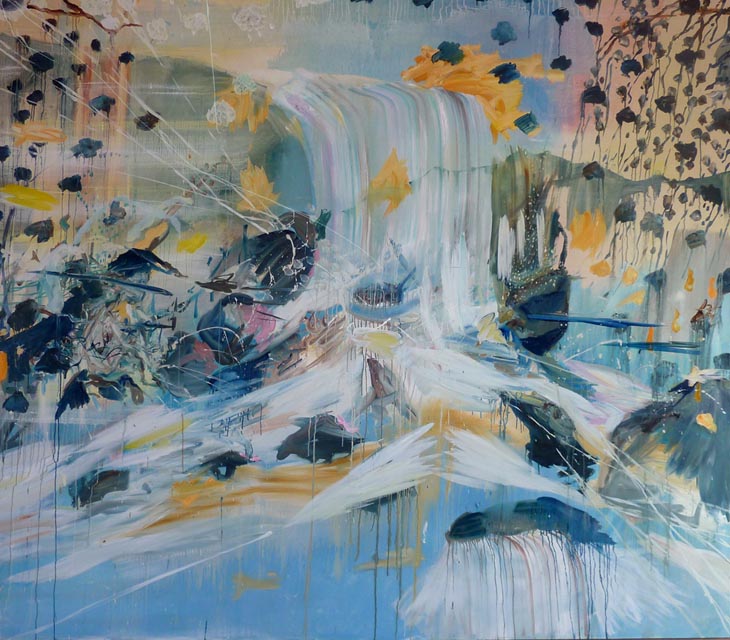
Fig. 9. Emson, A. Birthing Waters (2011)
Similarly to Hitchens’ works, Emson seems to use very limited movements to create her chosen marks. The contrasts between the light and dark are much more pronounced in these works. Again, this artist appears to have mastered the concept of allowing the piece to become its own entity. This is definitely something to bear in mind and being able to see it in practice makes it much easier to understand and appreciate.
James Dickson Innes
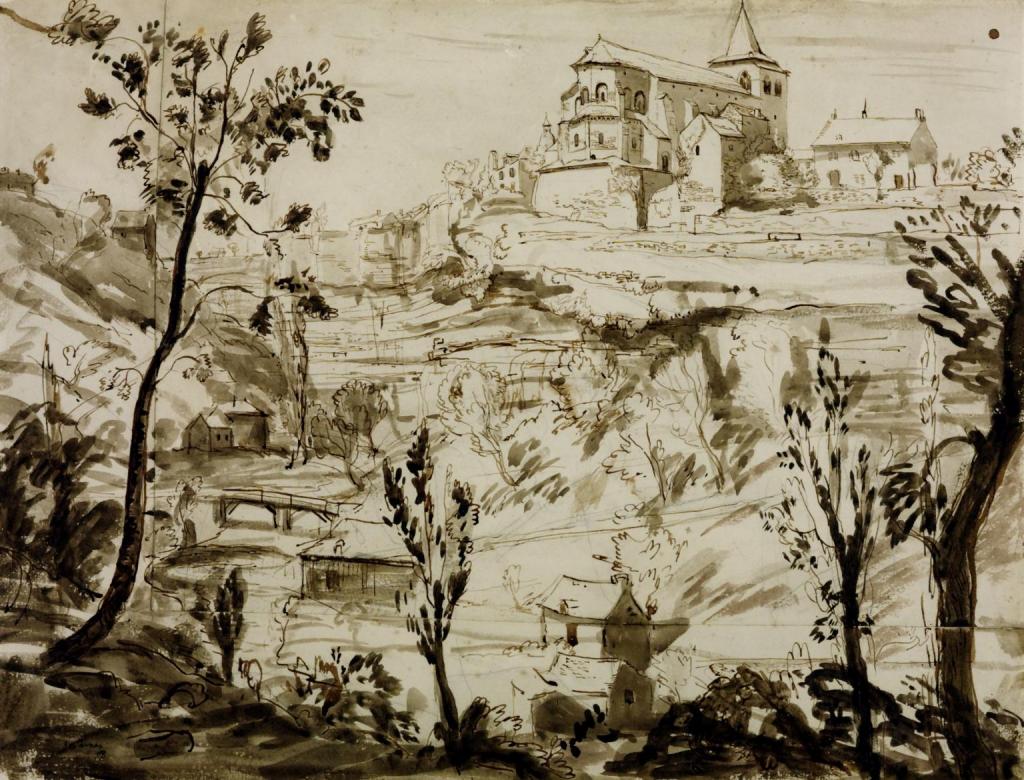
Fig. 10. Dickson Innes, J. Bozouls, near Rodez (1908) 
Fig. 11. Dickson Innes, J. Twilight in Averyon (1908) 
Fig. 12. Dickson Innes, J. Girl Standing by a Lake (c.1914)
I really like the different yet somehow similar approach throughout the three pieces chosen here. There is a fluidity apparent between all three pieces and the depth within them all is very strong, with the foreground detail being rather bold and eye-catching. The colours are very subtle and gently applied. This is something I could definitely learn from due to having quite a heavy-handed approach.
George Baselitz

Fig. 13. Baselitz, G. Rebel (1965) 
Fig. 14. Baselitz, G. Eagle (1981) 
Fig. .15 Baselitz, G. Adieu (1982)
These pieces are very different to the earlier works and appear to have been created with a much heavier hand, yet are still rather delicate in their appearance. I quite like how the artists has turned the forms upside down in two of the pieces, creating a rather surreal and disturbing sensation for the viewer. The colours used are rather subdued, even though they are quite bold colours. As opposed to the previous artists, this one seems to enjoy the experiment and potential errors as a result and seems to embrace them. Clearly this is a confidence equal to those of the earlier artists yet instead of creating pieces void of error, this artist embraces those errors and showcases them within their work. Yet another concept to bear in mind.
Albert Oehlen
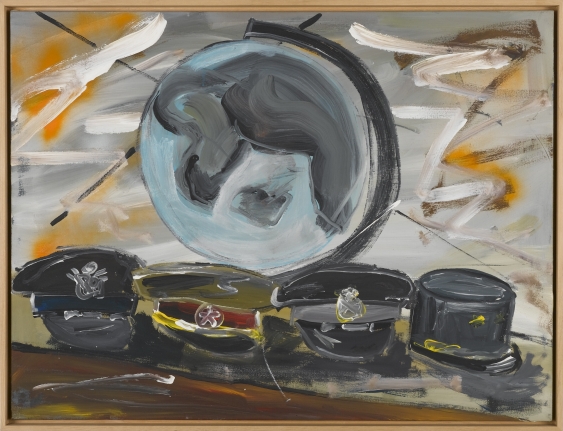
Fig. 16. Oehlen, A. Mutzen (Untertitel: Warnung vor dem Hunde (1981) 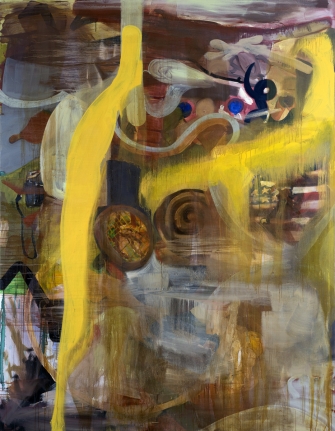
Fig. 17. Oehlen, A. Fri 31 (1990) 
Fig. 18. Oehlen, A. Rasieren (2005)
I absolutely love these pieces. I really like how the forms within them appear to almost not exist within the chaos of the pieces, yet are visible when viewed more closely. I really like the layers created and the endless visual information held within. This chaos is really exciting to me and draws me in. This is completely contrary to the previous artists’ aim of minimalism. Clearly chaos is just as appealing as order and both equally as achievable.
Philip Guston
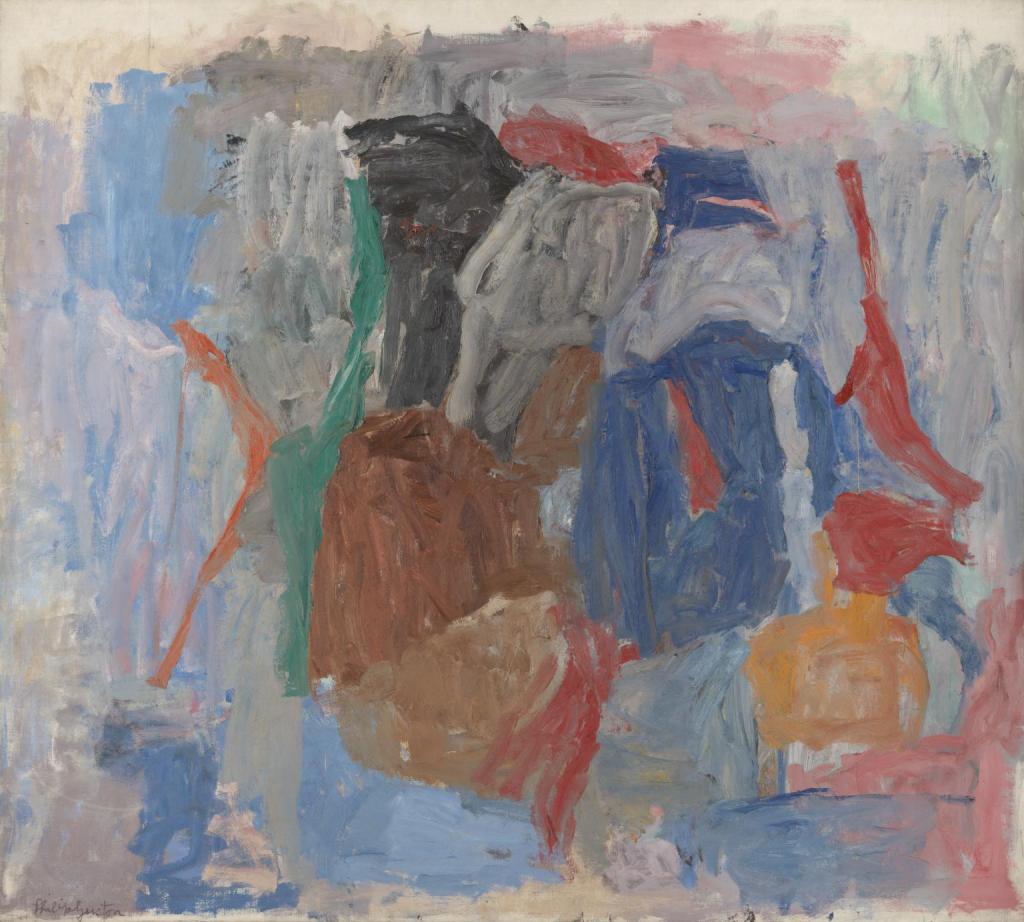
Fig. 19. Guston, P. The Return (1956-8) 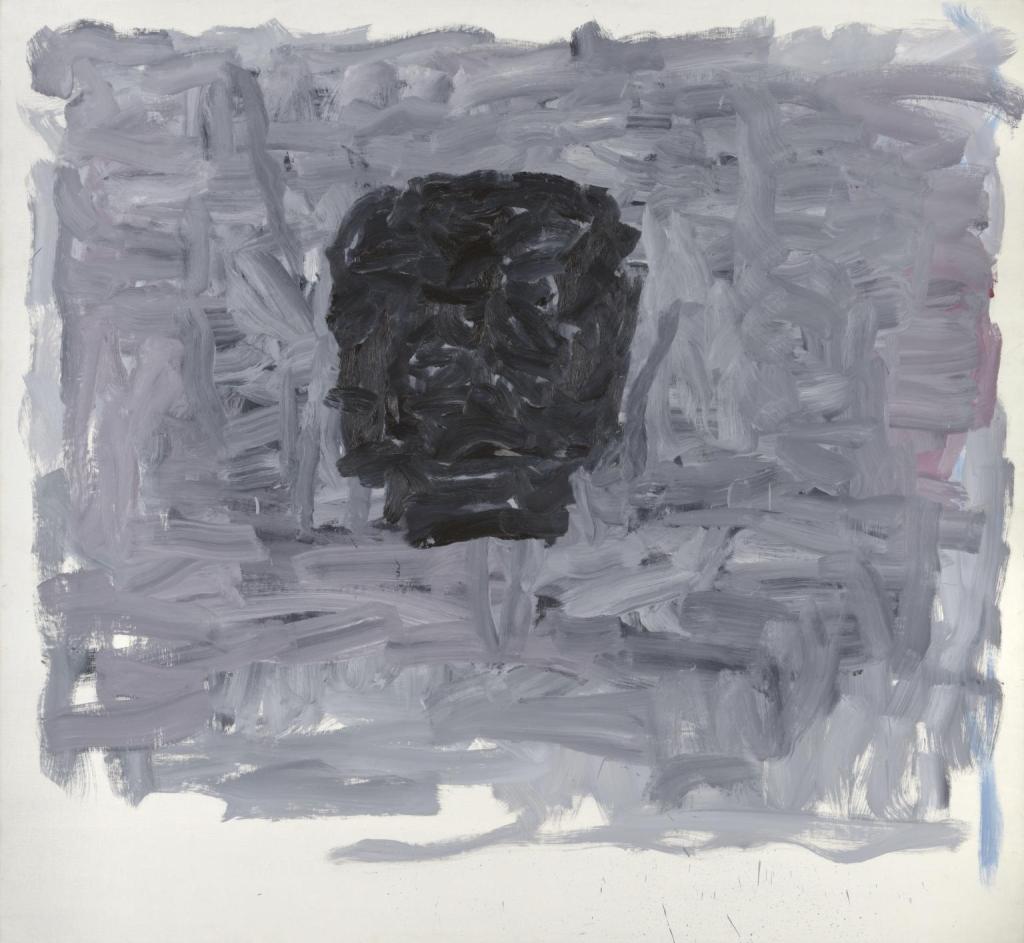
Fig. 20. Guston, P. Head I (1965) 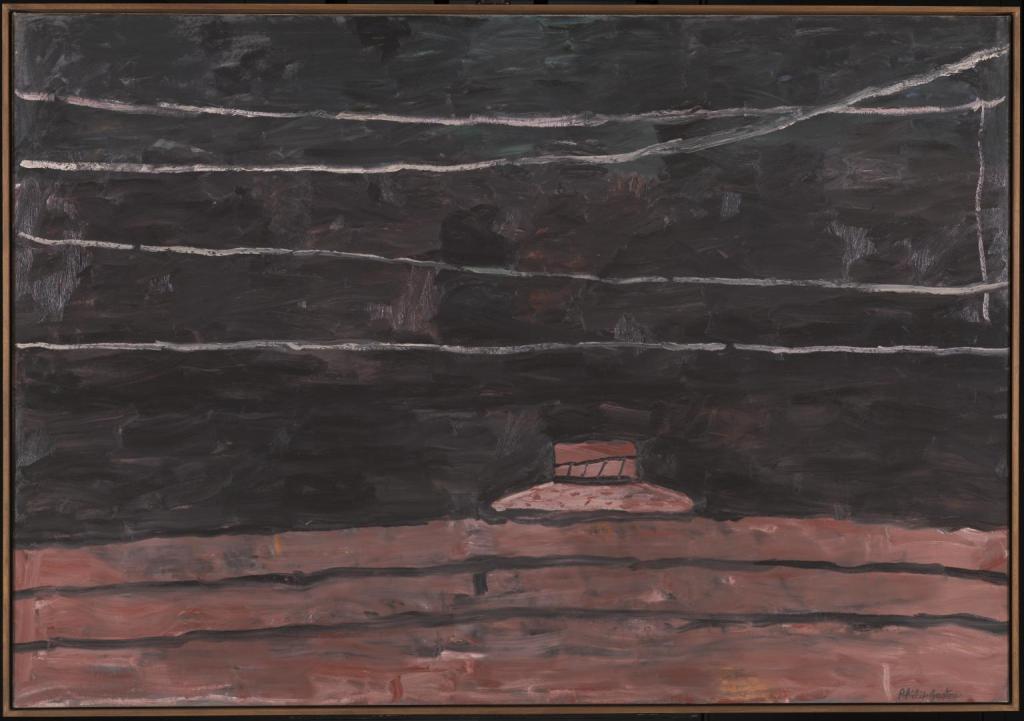
Fig. 21. Guston, P. Hat (1976)
This artist appears to enjoy the muddy and dull colours created by mixing colours together. The works are rather muted and yet hold a sinister feel within them. Whilst I do not think this muddiness appeals to me, I can see how it has been manipulated to serve this artist’s purpose and how effective it can be when used purposefully and efficiently.
Markus Lupertz
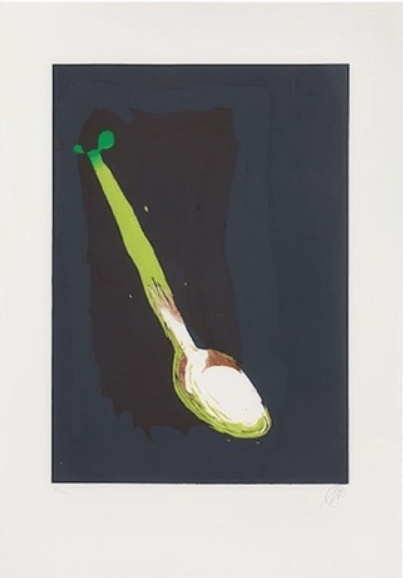
Fig. 22. Lupertz, M. Versteinerte Tropfen VI (1990-2000) 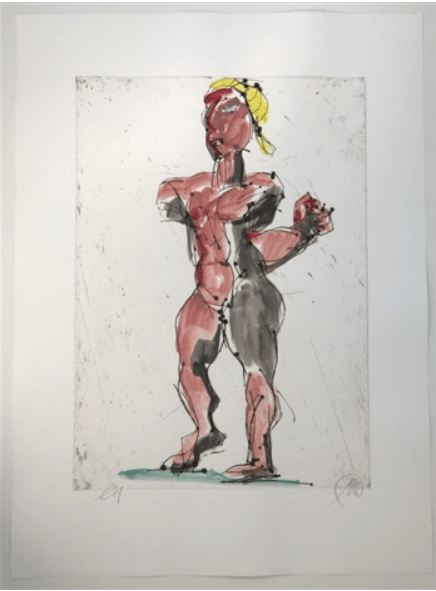
Fig. 23. Lupertz, M. Mozart (2005) 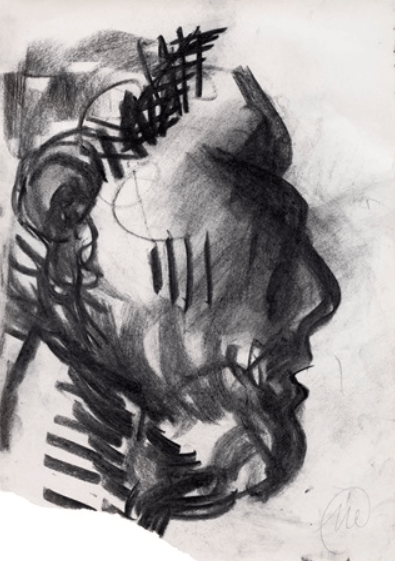
Fig. 24. Lupertz, M. Ohne Titel (Herkules) (2010)
This artist has a very minimalistic approach to his work and the contrasts held within are very strong and instantly apparent. The marks made are very confident and determined and the piece is created with minimal effort. Again, this is definitely food for thought and something I should consider before applying my marks to try to achieve that confidence within my own works.
Michael Borremans: A Knife in the Eye (2011)
From watching this film, I feel I have been given a good insight into this artist’s purpose and personality. He appears to be rather emotionally involved in the creative process, even having his studio at home so it is always accessible should he have a sudden burst of inspiration. He also advises of how he can be unbearable to be around if a piece is not coming together correctly. He sees his works as experiments and they are, indeed, very experimental in nature. He advises how he likes his pieces to grab not only the viewer’s attention, but more so his own, and for powerful smaller pieces – like a knife in the eye – as opposed to larger ‘normal’ pieces. I can appreciate this sentiment as I, too, enjoy my pieces having some sort of impact and pull to them.
I find it rather interesting how he prefers to wear his suits whilst painting to purposefully avoid spilling any paint on them which demands a level of restraint and concentration. I can relate quite well to this as I regularly carry out my creative processes whilst at work, wearing my ‘work’ clothes, but this is also how I feel ready to paint; since being young, I have needed to get dressed in the mornings, whether it be my intention to leave the house or not, as to remain in my pyjamas leaves me sluggish and ‘slobby’ and I simply cannot function well, so I feel I can relate well with this comment and mindset. I can also relate to his comments regarding becoming lost in one’s work and the process.
I find it rather intriguing how his works appear to have hidden agendas; they appear to be the ‘perfect’ piece, yet their story is of a sinister nature and can appreciate his description of it being as one who writes perfect sentences, yet the words are all wrong. I can fully appreciate the meaning within this and actually find it rather fascinating to consider.
Borremans seems to enjoy the influences of earlier artists and finding semblances of their work within his own. He seems to have a great appreciation for earlier artists and of paying homage to them, as well as taking pride in his own work when he has achieved this, even if only found in small sections of his works.
One thing I found fascinating from the video was how Borremans admits searching out models who resemble those from earlier drawings to enable him to create bigger pieces. I find this rather disturbing but fascinating at the same time; it reminds me of a serial killer searching out their prey, for instance, yet I am unsure why that is.
I also love Borremans’ enjoyment in using found papers / supports to use to create his pieces on. This is actually a really fascinating concept and I can really appreciate how this can lead to much more interesting narratives and questions within a piece.
Overall, whilst I already had an admiration for Borremans’ works, I feel this video has been really inspirational in allowing me to glimpse his mind’s eye’s view of the world around him, but also for having provided me with ideas and areas to investigate in the future.
Philip Guston: A Life Lived (1981)
Rather in comparison to the earlier Borremans’ research, this was an artist I was not aware of and, quite frankly, did not really feel I understood the works of. I was rather dubious as to what the video would show and whether I would be interested in it, however, I could not have been more wrong. Almost as soon as this artist began speaking, I felt a connection, admiration and warmth for this artist which was somewhat lacking with the earlier artist. Whilst I admired him and his work, I felt there was still a slight disconnect, whereas here I felt almost compelled to appreciate the work due to the respect felt for the artist, and so I found myself appreciating the work more and more as the video progressed. I was actually rather truly saddened when at the end of the video it became apparent Guston had passed away quite some time ago, which I think shows jut how much respect is due to his memory.
I think the title of the video could also not be more fitting a tribute as his works really do seem to be almost frames in a comic book / cartoon strip of his life with his constant changing methods which at first appeared rather disconnected and separate, yet become easily understood to have evolved from each other when listening to the artist’s story of constantly investigating routes and then going back and considering limbs of the investigation which had been left untouched previously and believing no time would ever be enough to fully investigate every avenue and to learn every aspect of his skill. This is definitely something I can relate to as I often having racing thoughts which may start with a single concept, then run off in a million directions, with only a few ever actually being pursued and the numerous others simply fading into nothingness, which I do agree is a rather sad realisation.
I find Guston to be a very humble person and artist; working odd jobs to bring money in and painting in the evenings and on weekends, and not being too above himself to be able to destroy works he does not necessarily connect with or he feels are becoming too ‘perfect’.
I find it fascinating that Guston began working in abstract ways, almost simple blurs of splodges on a support, which then seemed to evolve from there to find subtle suggestions of form, which then became more and more defined figurative pieces. This process really does remind me of the human evolution from simple cells all the way through to our human form today. It is fascinating. Whilst most artists tend to work in the opposite manner, working very tight and restricted in the beginning and then working to loosen themselves up (as I have found throughout this course!) which is daunting but at the same time liberating, Guston instinctively had this liberation initially which I feel is very humble and impressive.
As stated, I feel I have found a much greater appreciation for this artist’s work since having gotten to know the artist on a more personal basis and so I think this has taught me that, should an artist’s work not really seem to move me, inspire me or appeal to me, perhaps I should try to learn more about the artist themselves and their reasonings as to why they would create such pieces in the first place before simply stating ‘no, that’s not for me’, so to speak.
List of Illustrations
Fig. 1. Hitchens, I. (1941) Damp Autumn [Unknown] At: https://www.tate.org.uk/art/artists/ivon-hitchens-1291 (Accessed on 13 February 2021)
Fig. 2. Hitchens, I. (c.1942) Studio with Open Doors [Unknown] At: https://gardenmuseum.org.uk/exhibitions/ivon-hitchens-the-painter-in-the-woods/ (Accessed on 13 February 2021)
Fig. 3. Hitchens, I. (1951) River Rother, Dark Evening [Oil on canvas] At: https://www.nationalgalleries.org/art-and-artists/artists/ivon-hitchens (Accessed on 13 February 2021)
Fig. 4. Na Kamura, M. (2008) PML IX [Oil on canvas] At: http://www.jirisvestkagallery.com/artist-detail/maki-na-kamura (Accessed on 13 February 2021)
Fig. 5. Na Kamura, M. (2011) fGf XXVII [Unknown] At: https://calsfieldnotes.wordpress.com/2016/07/30/maki-na-kumara/ (Accessed on 13 February 2021)
Fig. 6. Na Kamura, M. (2017) dXd XXIII [Oil and water on canvas] At: https://artmap.com/cfaberlin/exhibition/maki-na-kamura-2017 (Accessed on 13 February 2021)
Fig. 7. Emson, A. (2006) Steps [Oil on canvas] At: https://saatchigallery.com/artist/annabel_emson (Accessed on 13 February 2021)
Fig. 8. Emson, A. (2006) Heaven [Oil on canvas] At: https://saatchigallery.com/artist/annabel_emson (Accessed on 13 February 2021)
Fig. 9. Emson, A. (2011) Birthing Waters [Oil on canvas] At: https://saatchigallery.com/artist/annabel_emson (Accessed on 13 February 2021)
Fig. 10. Dickson Innes, J. (1908) Bozouls, near Rodez [Graphite and watercolour on paper] At: https://www.tate.org.uk/art/artworks/innes-bozouls-near-rodez-n03660 (Accessed on 13 February 2021)
Fig. 11. Dickson Innes, J. (1908) Twilight in Aveyron [Watercolour on paper] At: https://www.tate.org.uk/art/artworks/innes-twilight-in-aveyron-n03676 (Accessed on 13 February 2021)
Fig. 12. Dickson Innes, J. (c.1914) Girl Standing By A Lake [Unknown] At: https://en.wikipedia.org/wiki/James_Dickson_Innes#/media/File:Girl_Standing_by_a_Lake_James_Dickson_Innes.jpg(Accessed on 13 February 2021)
Fig. 13. Baselitz, G. (1965) Rebel [Oil on canvas] At: https://www.tate.org.uk/art/artworks/baselitz-rebel-t03442 (Accessed on 13 February 2021)
Fig. 14. Baselitz, G. (1981) Eagle [Woodcut on paper] At: https://www.tate.org.uk/art/artworks/baselitz-eagle-p07779 (Accessed on 13 February 2021)
Fig. 15. Baselitz, G. (1982) Adieu [Oil on canvas] At: https://www.tate.org.uk/art/artworks/baselitz-adieu-t03672 (Accessed on 13 February 2021)
Fig. 16. Oehlen, A. (1981) Mützen (Untertitel: Warnung vor dem Hunde) [Oil on canvas] At: https://www.skarstedt.com/artists/albert-oehlen?view=slider#5 (Accessed on 13 February 2021)
Fig. 17. Oehlen, A. (1990) Fri 31 [Oil on canvas] At: https://www.skarstedt.com/artists/albert-oehlen?view=slider#4 (Accessed on 13 February 2021)
Fig. 18. Oehlen, A. (2005) Rasieren [Oil, resin and paper on canvas] At: https://www.skarstedt.com/artists/albert-oehlen?view=slider#2 (Accessed on 13 February 2021)
Fig. 19. Guston, P. (1956-8) The Return [Oil paint on canvas] At: https://www.tate.org.uk/art/artworks/guston-the-return-t00252 (Accessed on 13 February 2021)
Fig. 20. Guston, P. (1965) Head I [Oil paint on canvas] At: https://www.tate.org.uk/art/artworks/guston-head-i-t07131 (Accessed on 13 February 2021)
Fig. 21. Guston, P. (1976) Hat [Oil on canvas] At: https://www.tate.org.uk/art/artworks/guston-hat-t07132 (Accessed on 13 February 2021)
Fig. 22. Lupertz, M. (1990-2000) Versteinerte Tropfen VI [Linocut] At: http://www.artnet.com/artists/markus-l%C3%BCpertz/versteinerte-tropfen-vi-a-pbrTTJQNzYMLRxZzPxlT_g2 (Accessed on 13 February 2021)
Fig. 23. Lupertz, M. (2005) Mozart [Prints and multiples] At: http://www.artnet.com/artists/markus-l%C3%BCpertz/mozart-a-vCpcVGI2OFQrNxljpBUqhw2 (Accessed on 13 February 2021)
Fig. 24. Lupertz, M. (2010) Ohne Titel (Herkules) [Works on paper, charcoal on paper] At: http://www.artnet.com/artists/markus-l%C3%BCpertz/ohne-titel-herkules-a-5edNYn7BdBT9W-ahEiSnRQ2 (Accessed on 13 February 2021)
Bibliography
Michael Borremans: A Knife in the Eye (2011) Directed by Guido De Bruyn [YouTube] At: https://www.youtube.com/watch?v=dhhUmwmlMtc (Accessed on 18 February 2021)
Philip Guston: A Life Lived (1981) Directed by Michael Blackwood [YouTube] At: https://www.youtube.com/watch?v=h8eczPx7OZo (Accessed on 18 February 2021)

